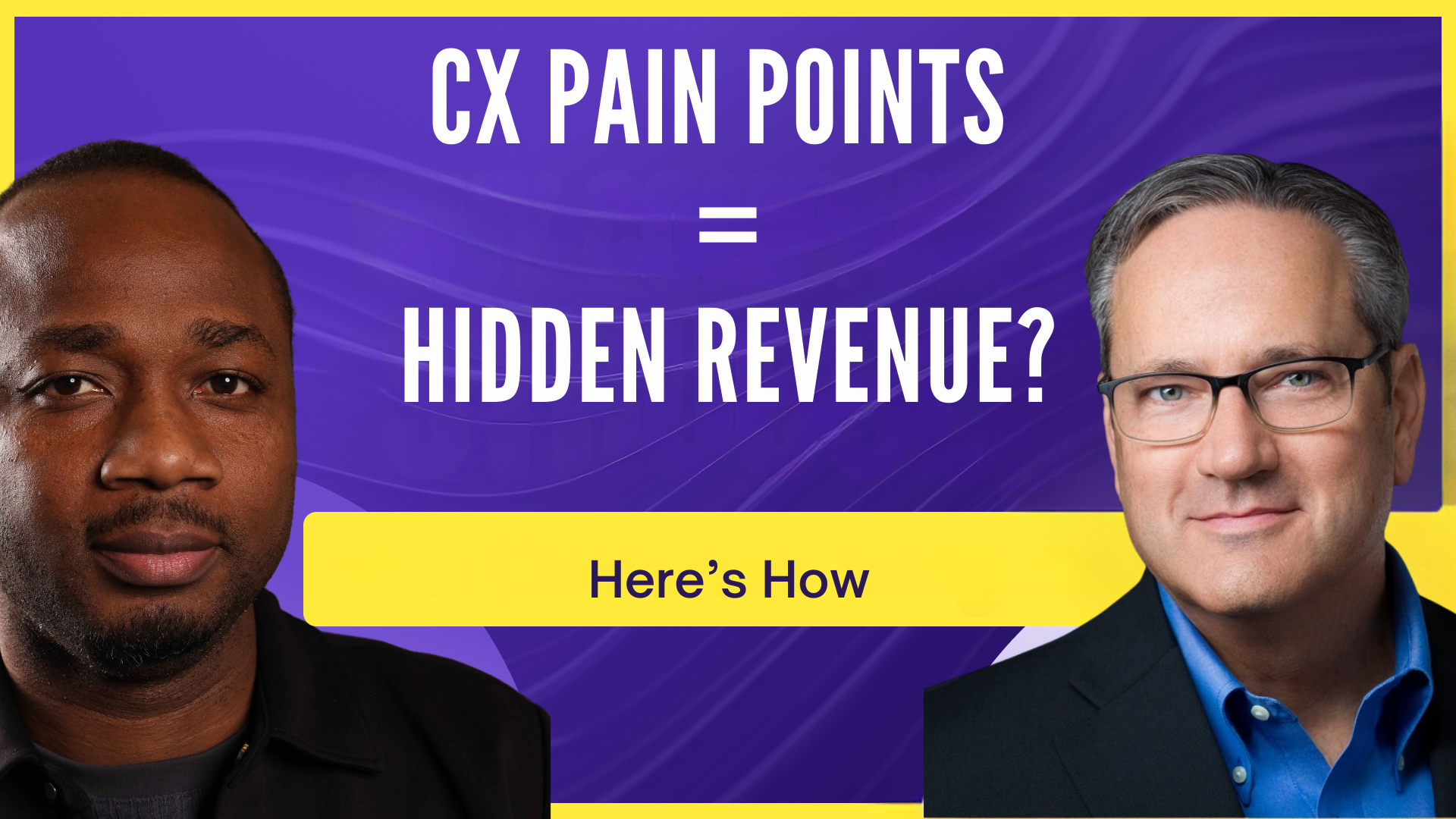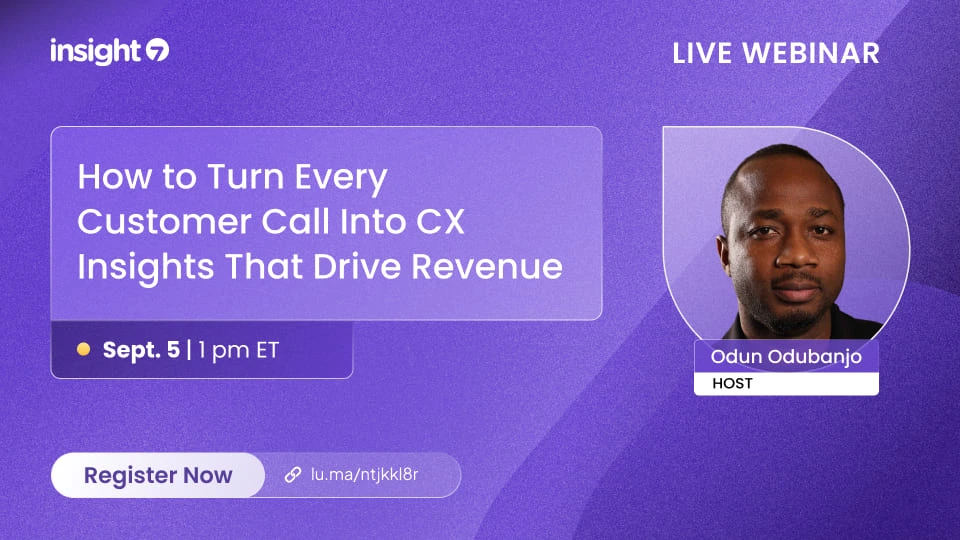AI Agent for Predictive Brand Perception Analysis
-
Bella Williams
- 10 min read
Foresight Brand Analysis stands at the intersection of innovation and understanding in today's competitive landscape. As brands are inundated with feedback and data, the need for predictive tools becomes crucial. These tools leverage advanced AI capabilities like machine learning and natural language processing, allowing organizations to sift through consumer insights effectively and anticipate trends before they emerge.
By integrating AI into brand perception analysis, companies can tailor their marketing strategies with precision. This proactive approach not only informs product development but also enhances customer engagement by addressing needs and preferences directly. In this way, Foresight Brand Analysis empowers brands to navigate market dynamics and foster deeper connections with their audience.
Analyze & Evaluate Calls. At Scale.

The Role of AI in Foresight Brand Analysis
Artificial Intelligence plays a crucial role in Foresight Brand Analysis by pinpointing emerging trends and consumer sentiments. With capabilities such as machine learning and natural language processing, AI systems can digest vast amounts of data to reveal insights that traditional methods may overlook. This efficiency allows brands to stay ahead of market dynamics and consumer preferences, ultimately crafting more relevant marketing strategies.
Moreover, predictive analytics enables brands to anticipate consumer behavior more accurately. By analyzing past interactions and current trends, AI tools can suggest tailored marketing strategies that resonate with targeted demographics. This proactive approach not only enhances brand loyalty but also optimizes resource allocation. In a rapidly evolving marketplace, integrating AI into Foresight Brand Analysis provides organizations with the competitive edge they need to thrive. Embracing these technologies ensures brands are not just reacting to changes, but actively shaping their market presence.
Understanding AI Capabilities
Artificial Intelligence (AI) offers remarkable capabilities for Foresight Brand Analysis, enabling brands to decipher consumer attitudes and perceptions with precision. Understanding AI functionalities is fundamental to leveraging this technology effectively. AI can process vast datasets rapidly, uncovering patterns that traditional analysis might miss. By utilizing machine learning algorithms, organizations can predict shifts in brand perception alongside emerging consumer preferences.
Natural language processing (NLP) enhances these capabilities by allowing AI to interpret and analyze text from various sources, such as social media or online reviews. This ability helps brands gauge sentiment, identify trends, and articulate what consumers value. As brands employ AI in predictive brand perception analysis, they gain a clearer understanding of their market positioning. This insight empowers companies to tailor marketing strategies, anticipate consumer behavior, and ultimately foster stronger connections with their audience, ensuring they remain proactive rather than reactive in an ever-evolving market landscape.
- Overview of AI functionalities in brand analysis
AI functionalities in brand analysis have revolutionized how businesses understand consumer perceptions and market dynamics. By harnessing techniques like machine learning and natural language processing, brands can analyze vast datasets to extract meaningful insights. This analytical capability allows companies to proactively understand shifting consumer behaviors, enabling timely adjustments to strategies.
One vital aspect of these AI functionalities is predictive brand perception analysis. This process anticipates how consumers might react to products or marketing campaigns, informing more effective communication strategies. Such foresight ensures that brands not only respond to market changes but also lead in innovation. For organizations committed to staying ahead, integrating these AI tools is no longer optional but essential for sustainable growth and relevance in today's fast-paced market environment.
- The importance of machine learning and natural language processing
Machine learning and natural language processing are fundamental in the realm of predictive brand perception analysis. These technologies enable businesses to process vast amounts of unstructured data, turning raw customer conversations into actionable insights. By employing machine learning algorithms, organizations can identify patterns and trends in consumer behavior, allowing them to anticipate shifts and preferences in real-time. This dynamic capability significantly enhances brand strategies, empowering marketers to adjust their messaging promptly.
Natural language processing complements this by interpreting customer sentiments and extracting meaningful information from conversations. This fusion of technologies provides a comprehensive understanding of brand perception, which is crucial for effective decision-making. By utilizing insights derived from machine learning and natural language processing, companies can refine their approaches, ensuring they remain competitive in a fast-paced market. Thus, the importance of these technologies cannot be understated, as they form the backbone of Foresight Brand Analysis in enhancing overall brand efficacy.
Key Benefits of Predictive Brand Perception Analysis
Predictive Brand Perception Analysis offers significant advantages for businesses striving to stay ahead of the curve. A critical benefit is the ability to anticipate consumer behavior. By analyzing historical data and identifying trends, businesses can foresee potential shifts in customer preferences, enabling proactive response strategies. This foresight allows brands to adjust their messaging and product offerings to align with evolving sentiments.
In addition to anticipating trends, this analysis empowers brands to tailor marketing strategies effectively. Understanding how target audiences perceive a brand provides insights into what resonates with consumers. Consequently, marketing efforts can be customized to enhance engagement and foster loyalty. Utilizing data-driven insights, organizations can create campaigns that not only attract attention but also facilitate deeper connections with their customers. Overall, the integration of Foresight Brand Analysis in strategic decision-making positions brands to achieve sustained relevance and growth in competitive markets.
- Anticipating consumer behavior
Understanding consumer behavior is pivotal in successful brand perception analysis. Anticipating consumer behavior enables brands to not only react to current market trends but also proactively shape their strategies to meet future demands. This foresight allows companies to stay ahead of competitors by aligning their offerings with evolving customer preferences.
To effectively anticipate consumer behavior, a few key strategies can be employed.
Data Analysis: Collecting and analyzing consumer data aids in identifying patterns and trends that indicate shifting preferences.
Sentiment Tracking: Monitoring social media and customer feedback provides insights into consumer sentiments regarding the brand.
Predictive Modeling: Utilizing AI algorithms can forecast future behaviors based on past data, allowing for more informed decision-making.
By implementing these strategies, brands can not only anticipate consumer behavior but also optimize their marketing efforts. This proactive approach ultimately enhances their effectiveness in delivering the right products and experiences to their target audience.
- Tailoring marketing strategies effectively
Tailoring marketing strategies effectively requires an understanding of the nuances in consumer behavior. By utilizing Foresight Brand Analysis, businesses can anticipate shifts in brand perception before they occur. This proactive approach enables companies to craft marketing messages that resonate with their target audience's evolving preferences.
One key aspect is integrating data from multiple sources. Businesses can enhance their strategies by analyzing customer insights from social media, surveys, and direct interactions. This comprehensive view ensures that marketing campaigns are relevant and precise, addressing the specific needs and desires of consumers.
Another critical factor is adapting in real-time. As new data emerges, marketing strategies can be fine-tuned to reflect changing perceptions. This flexibility allows brands to stay ahead of the competition and foster stronger relationships with their audience, ultimately driving engagement and loyalty. Embracing a data-driven mindset ensures that strategies are not merely reactive, but rather aligned with consumer expectations moving forward.
Extract insights from interviews, calls, surveys and reviews for insights in minutes
Tools for Effective Foresight Brand Analysis
Tools for effective foresight brand analysis enable organizations to gain deeper insights into consumer perception. These tools leverage advanced algorithms that analyze vast amounts of data, making it easier to predict market trends. By integrating artificial intelligence into the brand analysis process, companies can anticipate consumer behavior and adjust their strategies accordingly.
Key tools play a critical role in this landscape. For instance, Insight7 provides a user-friendly platform, allowing teams without technical expertise to derive actionable insights from customer interactions. Additionally, platforms like Brandwatch utilize social listening to capture real-time consumer sentiments, while Talkwalker offers multi-channel analytics to understand brand performance. Each of these tools helps businesses adapt by identifying emerging trends and consumer preferences, ultimately leading to more effective marketing strategies. Embracing these tools can transform how brands approach market insights, facilitating more informed decision-making and strategic planning.
Insight7 as a Leading Tool
Insight7 stands out as a transformative tool in the realm of Foresight Brand Analysis. Its innovative platform enhances the ability to analyze customer conversations and data at scale, streamlining the process for organizations of all sizes. By offering a self-service approach, Insight7 allows users to effortlessly access and interpret vast amounts of data, addressing the complexity and speed required in today’s data-driven world.
One of the primary advantages of Insight7 is its capacity to gather multiple customer signals efficiently. This enables companies to stay ahead of competitors by responding swiftly to changing consumer behaviors. Traditional methods often slow down this process, leading to missed opportunities for actionable insights. With Insight7, users can consolidate insights, fostering better collaboration and driving strategic business actions based on reliable customer feedback. This efficiency not only optimizes time but also enhances the quality of analysis, making it an essential tool for brands looking to elevate their perceptive strategies.
- Unique features and capabilities of Insight7
Insight7 stands out in the realm of Foresight Brand Analysis through its innovative features and modern capabilities. One of its key strengths is the ability to synthesize vast amounts of data, allowing businesses to gain deep insights into consumer perceptions. This not only enhances understanding but also streamlines the process of interpreting complex conversations around brand sentiment.
Another remarkable capability is its integration of advanced machine learning algorithms. This technology enables predictive analytics that can foresee shifts in consumer behavior, thus allowing brands to stay one step ahead. The agility of Insight7 in adapting to evolving market trends provides companies with actionable insights. Ultimately, these features empower businesses to craft personalized marketing strategies that resonate with their audience, ensuring their brand remains relevant and impactful in a competitive landscape.
- Case study on Insight7 in action
Understanding the practical applications of Foresight Brand Analysis can be exemplified through a case study showcasing a leading AI-driven tool. In this scenario, companies faced unprecedented challenges in processing vast amounts of customer-generated data. They struggled with traditional methods that were unable to keep pace with their growing analytical needs. As a result, they sought innovative solutions that could streamline their processes and deliver insights more efficiently.
Successfully implementing the AI agent facilitated the transformation of raw data into actionable intelligence. This case study reveals how organizations can harness insights from interviews and customer interactions. By doing so, they significantly improved decision-making and collaboration within teams. Leveraging real-time analytics, the companies gained quicker access to key information, enabling them to anticipate consumer behavior and tailor their marketing strategies accordingly. Such advancements underscore the pivotal role of Foresight Brand Analysis in maintaining a competitive edge in today's market.
Other Notable AI Tools for Brand Perception
The realm of brand perception analysis is enriched by various AI tools beyond the primary offerings. These notable tools, each with unique attributes, make significant contributions to understanding brand health and consumer sentiment. Brandwatch excels in social listening, capturing conversations across platforms to provide actionable insights into brand perception. Users can identify trends in real time, allowing for swift strategic adaptations.
Talkwalker enhances multi-channel analytics by integrating data from various sources, enabling brands to grasp a broader view of consumer sentiments. Sprinklr focuses on unified customer experience management, delivering insights to enhance customer interactions. Lastly, NetBase Quid offers fast, scalable consumer intelligence, ideal for drawing insights from large datasets. Together, these tools perform essential roles in a comprehensive Foresight Brand Analysis, empowering brands to anticipate shifts and make informed marketing decisions. Understanding these technologies is vital for businesses striving for a competitive edge in brand perception.
- Brandwatch: Leveraging social listening for brand insights
Employing effective social listening opens doors to actionable brand insights. This approach allows organizations to track sentiments, mentions, and trends across various social channels. By analyzing these conversations, brands can gain a deeper understanding of how the public perceives them, highlighting potential areas for improvement. Social listening tools streamline this process, transforming qualitative data into meaningful metrics. This is essential for organizations looking to enhance their Foresight Brand Analysis.
Effective implementation of social listening involves several key steps.
Monitoring Online Conversations: Continuous tracking of social media interactions helps identify rising trends and shifts in consumer sentiment.
Analyzing Audience Insights: Understanding the demographics, interests, and behavior of your audience enables brands to tailor their messaging effectively.
Identifying Competitor Performance: Social listening also provides insights into competitor branding strategies, offering valuable lessons for differentiation.
By focusing on these areas, brands can not only respond proactively to consumer needs but also predict future trends, creating a strategic advantage in their market.
- Talkwalker: Multi-channel brand analytics
Understanding multi-channel brand analytics involves examining how brands perform across various platforms. It is essential to gather data from these diverse channels to gain a holistic view of brand perception. This type of analysis allows brands to assess their strengths and weaknesses in real time, enabling strategic adjustments.
Multi-channel brand analytics provides insights into consumer behavior and preferences. By analyzing data from social media, review sites, and customer interactions, brands can identify trends and sentiments that impact their reputation. This understanding informs marketing strategies and product development. Ultimately, organizations that harness multi-channel analytics can achieve a competitive edge by anticipating consumer needs and refining their messaging, making foresight brand analysis a critical component in today's digital landscape.
In sum, tapping into various channels helps create a comprehensive outlook on brand health, guiding teams to translate insights into actionable strategies. This process supports brands in staying relevant and responsive in an evolving marketplace.
- Sprinklr: Unified customer experience management
Unified customer experience management is essential in today’s fast-paced digital environment, where consumer preferences shift rapidly. This approach integrates various customer touchpoints to create a cohesive user experience, allowing brands to engage effectively. By streamlining interactions, businesses can gather rich data insights that inform decision-making and strategy development.
Foresight Brand Analysis plays a crucial role in this landscape, providing the analytical framework needed to interpret customer behavior and brand perception effectively. This alignment enables organizations to anticipate changes in consumer sentiment and adapt their marketing strategies accordingly. Ultimately, employing a comprehensive management system empowers businesses to translate insights into actionable strategies, fostering stronger customer relationships and enhanced brand loyalty.
- NetBase Quid: Fast and scalable consumer intel
In today's rapidly changing market, understanding consumer sentiment is more crucial than ever. Fast and scalable consumer intelligence can empower brands to navigate these complexities with ease. Companies need instant access to insights that reflect the voice of the customer, enabling them to make informed decisions. This is where advanced analysis techniques come into play, offering a seamless experience to analyze vast datasets of consumer interactions.
Organizations can utilize predictive brand perception analysis to stay ahead of trends. By synthesizing customer signals, businesses can craft tailored marketing strategies that resonate with their target audiences. The effectiveness of these insights lies in the ability to quickly transform data into actionable strategies. In doing so, brands can not only enhance their competitive edge but also strengthen their relationship with consumers, driving loyalty and preference in the marketplace.
Conclusion: Harnessing Foresight Brand Analysis for Future Success
As we conclude our exploration of Foresight Brand Analysis, it is essential to recognize its transformative potential for future success. Utilizing AI tools to anticipate consumer trends allows brands to craft targeted marketing strategies, enhancing customer engagement. By analyzing data effectively, businesses can uncover insights that inform decision-making and foster adaptive strategies to meet evolving market demands.
Embracing Foresight Brand Analysis equips brands with the foresight necessary to navigate increasingly competitive landscapes. It empowers organizations to proactively address consumer needs and preferences, ensuring they remain relevant and effective. Ultimately, brands that invest in predictive analysis today will position themselves for sustainable success in the years to come.







